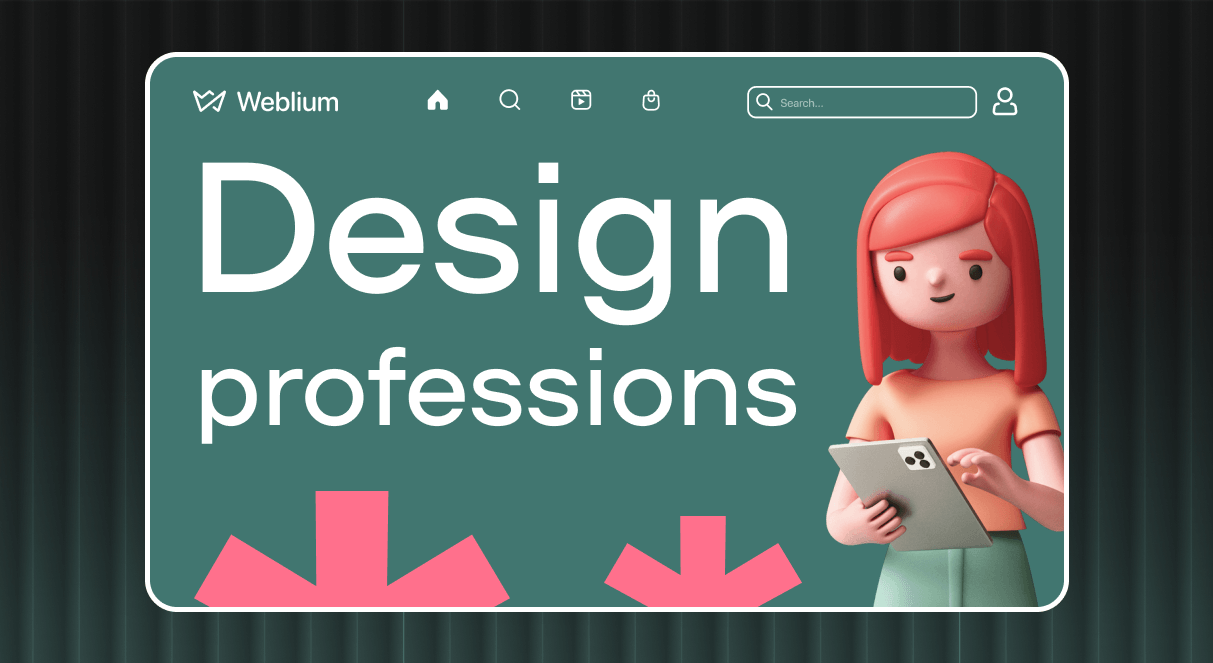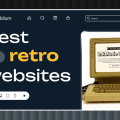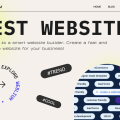
How to Start a Career in Design? 9 Types of Designers
Creative professions are often idealized. When a person from another industry imagines a designer’s work, they picture a pleasant image: you sit in a café with a MacBook, sip coffee, and create beautiful designs in two clicks. You can work as a freelancer with a free work schedule and fly to Bali to spend the winter. Sounds great, right? Still, this idyll rarely corresponds to reality.
The reality is that a designer’s occupation is often related to something other than creativity but to analytics, research, and testing. It implies a lot of hard and soft skills, which vary greatly depending on which design fields you pick.

If you are looking for a future career or considering switching to some design areas from another industry, you need to weigh the pros and cons. In particular, to understand the responsibilities of different design roles, the prospects for development in the industry, and the market situation. Today, many options and work formats exist: freelancing, working in a creative agency, product or service company. If you map out your career path and develop the necessary skills, you will succeed.
In this article, we’ll cover the areas of design and the skills and tools required for them. This may be the sign you’ve been waiting for to start your design career.
Contents
Graphic Designer
A graphic designer is a creative professional who develops visual concepts, mainly for marketing and advertising. They design logos, posters, packaging, promotional materials, and other visual elements that reflect the brand’s ideas and messages. These can include digital and printed materials.
In their work, designers use graphic software:
- Adobe Photoshop,
- Illustrator,
- InDesign,
- Figma;
and technical equipment:
- graphics tablet,
- computer.
A graphic designer needs to understand the basics of shapes, colors, and compositions, know the basic principles of design: balance, proportion, and color theory, analyze trends, and integrate them into their work.
Graphic designers can find jobs in creative agencies, design studios, advertising and marketing spheres, or work independently as freelancers.
UX/UI Designer
A UX/UI designer is responsible for creating interfaces for websites and applications that provide an optimal user experience with the product.
A UX (User Experience) designer analyzes and identifies user needs, generates ideas, and creates prototypes to improve the user experience.
A UI (User Interface) designer is responsible for the product’s visual aspect: interface design, positioning of elements on the screen, colors, and fonts.
Given the different responsibilities, the skills required in these two areas of design are distinct. For UX, analytical skills and understanding user behavior and needs, as well as technical features of the product, are essential. Valuable skills for a UI designer are creating aesthetic, user-friendly, and effective interfaces, i.e., implementing creative ideas that will meet user needs and achieve business goals.
In their work, UX/UI designers use the following tools to create mockups and prototypes:
- Sketch,
- Adobe XD,
- Figma,
- InVision,
- Adobe Comp,
- Mockflow.
These types of designers can work in IT companies, design agencies, or as freelancers on diverse projects. In collaboration with developers, marketers, and product managers, they create intuitive and aesthetic products that address user needs.
Web Designer
A web designer envisions and creates website architecture and appearance, developing the design concept and interface. Essential qualifications of this designer type include proficiency in graphic programs, understanding the basics of composition theory, color, typography, and UX/UI design principles, ability to analyze the target audience and meet user needs while achieving business goals.
A web designer uses various tools for design creation, from graphic programs to code editors, namely:
- Figma,
- Sketch,
- Illustrator,
- Photoshop,
- Dreamweaver,
- InDesign,
- Weblium,
- WordPress.
Programming and coding skills are not mandatory for a web designer. However, they will be handy, as basic knowledge of HTML and CSS and the ability to work with CMS (content management systems) help to figure out how to structure and design content on a website and how to use no-code programs.
A valuable tool for web designers is the Weblium website builder. This platform lets you quickly create a functional, attractive website design based on ready-made templates. To implement all creative ideas, you can also use the Flex block element, which lets you customize elements. With Weblium, creating an effective website is quick and easy.
A web designer can be employed in a web studio, marketing agency, freelance, IT, e-commerce, logistics company, or any other field.
Game Designer
A game designer creates a gaming experience, builds the game’s internal structure and gameplay, and develops scenarios, mechanics, and core game elements. This expert’s task is similar to the work of a movie director: they generate ideas and communicate them to the performers.
A must-have for a game designer is to love playing games, analyzing them, figuring out what components a game consists of, following trends, and what users are interested in. Game designers do not need to know programming languages, as implementing ideas is mainly the responsibility of technical specialists.
There are different design roles within the game design profession:
- a game mechanics and systems designer who is responsible for the rules of the game;
- a monetization designer who deals with the game economy;
- a level designer who creates game levels: locations, environments, and tasks on them;
- a narrative designer who crafts the game’s story.
To create games, a game designer uses specialized game development programs:
- Unity,
- Unreal Engine;
graphic editors for developing visual elements of the game, and technical programs for creating animation, sound design, and other aspects.
For a game designer, a broad outlook is vital, including basic knowledge of mathematics, physics, geography, chemistry, and history, as some game plots and settings require the most realistic representation possible. Good communication and organizational skills and the ability to convey your idea are also essential for successful project implementation.
Game designers can work in game development studios and IT companies and collaborate with programmers, artists, animators, and other specialists.
Motion Designer and Animation Designer
Animation designers, or animators, create moving images that tell stories or convey information. Animators primarily specialize in freehand drawing, creating digital pictures, or 2D/3D characters.
A motion designer is a combination of a graphic designer and an animator. They develop animated designs for various media formats: videos and presentations, digital ads, and GIFs.
The difference between these two fields of design lies in the projects they work on. Animators often create characters and settings, while motion designers work on graphics and visual effects.
Another distinction between these two types of designers lies in their specific skills. Animators need to grasp traditional animation techniques such as drawing and composition and be familiar with anatomy and character creation. In contrast, motion designers should master typography and visual language skills and have graphic design experience.
To create animations, the following tools are essential:
- After Effects,
- Cinema 4D,
- Animate,
- Premiere,
- Final Cut Pro,
- Photoshop,
- Illustrator.
Soft skills include perseverance and patience, an eye for detail, and creative thinking.
A motion and animation designer can work in IT, advertising, gaming, or television – anywhere there is a need for animation.
Product Designer
A product designer is a type of designer who is involved in product development, whether digital or physical. It can be a mobile app or a coffee machine. They do market research, develop concepts, create a user-friendly interface, prototype and test, evaluate, and improve the product.
A product designer should be able to address user needs and balance them with business requirements to implement a successful project. Product and UX are related design fields. The difference is that a UX designer develops a user-friendly interface and addresses user problems point-by-point. Product design covers all stages of business project development.
To create mockups and prototypes, a product designer needs to master the following tools:
- Sketch,
- Adobe XD,
- Figma,
- InVision,
- Illustrator,
- Photoshop,
- Adobe Comp,
- Mockflow.
Essential soft skills comprise strong communication skills with the team and clients, the ability to analyze user needs and gain business goals.
As mentioned above, the product can be digital or physical, so the potential workplaces also vary. It could be an IT company, an e-commerce company, a design agency, or any other area where there is a request for product enhancement.
Industrial Designer
The industrial design role is to create functional and aesthetically pleasing mass-produced products. An industrial designer researches the potential applications of a particular product and designs user-friendly and ergonomic items that meet the user’s needs.
Industrial designers use software or even hand drawings to create concepts, designs, and prototypes of products. Skills in working with 3D modeling and graphics programs are vital:
- SolidWorks,
- AutoCAD,
- Adobe Illustrator,
- Photoshop.
Analytical skills, the ability to identify user needs, and collaboration with engineers, marketers, and production staff are also valuable.
Typically, industrial designers specialize in a particular industry: automotive, furniture, household appliances, etc. Thus, they can work at manufacturing enterprises, design agencies, provide consultations, or freelance.
Interior Designer
The interior design of a property, the creation of a harmonious space where you want to stay, is the task of an interior designer. The designer creates a concept, plans the area, and determines the location of plumbing, heating systems, electrical wiring, and furniture. Based on technical requirements, they pick colors, materials, and textures.
The required hard skills encompass drawing and sketching skills, proficiency in interior design and modeling programs:
- AutoCAD,
- SketchUp;
software for drawings and visualizations:
- Revit,
- ArchiCAD,
- 3DsMax,
- Corona;
and the ability to work with graphic programs, for example, to create collages:
- Adobe Photoshop,
- Illustrator.
As for soft skills, having a good imagination, a creative approach to problem-solving, and sociability to communicate with clients and contractors is crucial.
Workplaces for an interior designer might be a design studio, an architectural firm, or a construction company. Projects can range from private to public spaces: offices, residential premises, hotels, restaurants, and other facilities.
Fashion Designer
A fashion designer develops, designs, and manufactures clothing, accessories, and footwear. Researching the market and customer needs, developing a concept, creating sketches, discussing them with the customer, putting them into production, and controlling quality are all part of a fashion designer’s job. A fashion designer can also take measurements, make patterns, and sew, but these are not their primary responsibilities.
Sewing skills, familiarity with different fabrics and accessories, a sense of style, good aesthetic taste, the ability to draw, analyze trends, draft technical documentation, and communication skills are crucial.
To develop collections, a fashion designer can use freehand drawings and sketches or programs:
- Adobe Illustrator,
- CorelDRAW.
A fashion designer can work at a garment company, in an atelier, in fashion brands and houses, with private customers, or independently under their brand.
How Can Aspiring Designers Find a Job?
If you’ve decided to start your career in the area of design and have chosen the profession that resonates with you the most, you should map out your professional path step by step. To get started, you should take specialized courses, follow trends and specialists in your design field.
A strong portfolio is the designer’s face, so you should pay particular attention to it. During your studies, you will work on design projects, and you can start building your portfolio using them. Where else can you find clients? Aspiring designers can offer their services to small businesses for free to gain work experience, or they can take an internship with the prospect of employment. Behance, a global creative community, is the best platform to build your portfolio.

If you are starting your career, your resume should include all relevant projects you worked on, even if you were not paid for them. Describe in detail the tasks you performed and the software you’re proficient in.
Remember to develop your creativity, follow trends, and grow personally and professionally. In this case, your dream job will find you!


